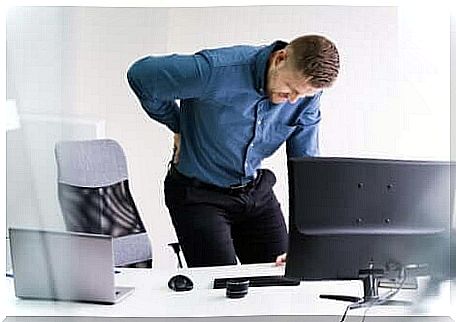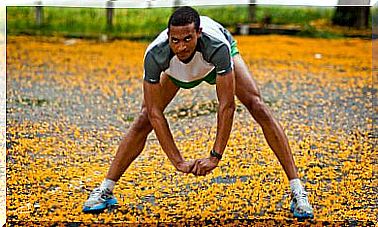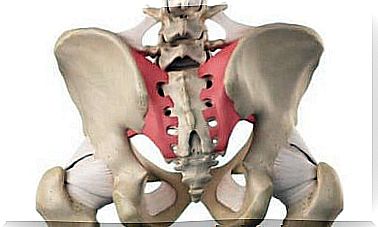3 Exercises To Avoid If You Have A Herniated Disc

Physical activity seems to contribute to the treatment of herniated disc, but due to the complexity of this lesion, we must take into account that exercises are contraindicated in these cases. As stated in an article published in Current Reviews in Musculoskeletal Medicine , this condition is one of the main causes of low back pain.
Although at first it is advisable to rest to avoid complications, as the days go by it becomes essential to activate the muscles through physical activity. This generally reduces pressure on the discs, maintains a healthy weight, and strengthens the core.
Still, it should be kept in mind that not all exercises are suitable for these cases. What are the exercises to avoid and why? Find out below!
What is a herniated disc?
To begin with, it is convenient to explain that the vertebrae in the vertebral column are separated by cartilaginous discs. These act as shock absorbers and are responsible for preventing friction between the bones. On the other hand, they act as ligaments and provide flexibility and mobility.
The disc is made up of two parts, each of which has a function:
- The nucleus : is the central part that absorbs the pressure between the vertebrae.
- The ring : is the outer part that limits rotation.
A herniated disc occurs when the nucleus pushes and expands outward due to a rupture in the outer ring. This can cause irritation or compression of a nearby nerve, causing pain or numbness.
Its possible causes include the following:
- Degeneration proper to aging.
- Wrong movements or excessive physical exertion.
- Trauma.
- Overweight and obesity.
- Type of work (if it involves high physical demand activities).
- Physical activity or sports.
Treatment is usually through pain relievers, rest, lifestyle changes and exercise. In rare cases it may require a surgical procedure. In addition, you also need to take some precautions and know what exercises to avoid.

Exercises contraindicated in case of disc herniation
Studies published in the International Journal of Sports Physical Therapy recognize the importance of exercise as part of the rehabilitation protocols for a herniated disc. While it is true that training should be individualized, it is generally best to avoid some activities.
1. Strength exercises
First, we should avoid exercises that place a load on the vertical axis of the spine. This is what happens with the squat, which is done by bending your knees as if you were squatting. This is usually done with a weight, with a barbell behind the neck.
Higher load exercises are also not recommended; for example, the so-called pressure military shoulder or pressure front. In this exercise, start the movement with the barbell at the shoulder line, with the hands facing upwards.
Soon after, the bar is pushed up. At its highest point, the bar is gripped and the hands are kept in a slanted position at shoulder height. Then raise the bar and extend your elbows.
But why avoid them? To perform them, it is necessary to keep your back as straight as possible, so that it can withstand the impact. Because of this, they are contraindicated exercises for those who suffer from herniated disc.
alternative exercises
In order not to exert too much force on the lower back, the practice of front squats is suggested. That is, those where the weight is not placed at the back, but at the level of the collarbone. Of course, it’s best to avoid squatting until the injury improves.
On the other hand, those who want to develop more volume can opt for the machine known as a press . In this exercise, the weight is also supported by the legs, but the impact is less as long as the person remains seated correctly, without lifting the glutes when pushing.
On the other hand, as an alternative to the military press , you can row, with your torso leaning, supporting one knee and one hand on a bench. This way you avoid overloading the affected part.
2. Abdominals
In herniated disc injuries that occur in the lower back, the sciatic nerve is also often affected. As a result, pains arise in the region of the waist and towards the hips, buttocks and legs.
Most abdominal exercises put pressure on the lower spine, creating tension at that point. This occurs both with the exercises in which the trunk is raised (upper) and those in which the legs are raised (lower).
Therefore, sit-ups, with or without weight, are contraindicated exercises in case of disc herniation problems. Even those using special devices are not recommended. Braces can help focus the effort to avoid bad movements, but they also force bending.
Alternative Abs
Planks are the best alternative for your abdominal muscles. They allow you to strengthen the abductor of the abdomen and keep the spine in a neutral position. There are several types of boards. The ones with less impact are as follows:
- Plank, anaerobic board or horizontal board: Lie facing the floor, with the body horizontal, supporting the weight with the forearms and the tip of the toes.
- Side plank: with the body lying on its side, bent over, supported on one elbow. Hold this position for a few seconds.

3. Stretches, rotations and hyperextensions
Stretches, rotations, and spine extensions are often ideal for starting a stronger exercise session. However, when treating a patient with a herniated lumbar disc, care must be taken.
Exercises where the knees touch the chest or the feet are touched with the legs straight can aggravate the injury. This is because the position can create more tension and friction on the discs. In a person with a herniated disc, this area should not bend too much or support weight.
alternative stretches
An alternative to not having too much impact on the spine is to work lying down, as is done in stretching the back, for example. In this way, it is possible to strengthen the spine, in addition to working the muscles and reducing tension in the lower back.
The oblique abdominal, which is also done lying down, is advisable to stretch the legs. This exercise is performed on the back, on a mat, with the legs bent. Then bend your knees to the left and right alternately.
Should we exercise in case of a herniated disc?
A herniated disc is not synonymous with inactivity. On the contrary, the practice of physical activity is suggested, albeit with some care. To exercise when there is a herniated disc, it is necessary to remember two important points: light weight and no tension in the spine.
The most important thing is to avoid a sedentary lifestyle, as this is often counterproductive to these injuries. Of course, it is ideal to exercise under the guidance of a professional trainer or physical therapist to avoid incorrect postures. In addition, you can perform low-impact activities such as yoga, swimming or Pilates.








